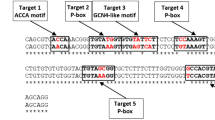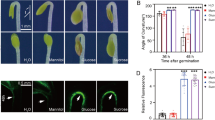Abstract
Pyrophosphate: fructose 6-phosphate 1-phosphotransferase (PFP) activity was successfully down-regulated in sugarcane using constitutively expressed antisense and untranslatable forms of the sugarcane PFP-β gene. In young internodal tissue activity was reduced by up to 70% while no residual activity could be detected in mature tissues. The transgenic plants showed no visible phenotype or significant differences in growth and development under greenhouse and field conditions. Sucrose concentrations were significantly increased in the immature internodes of the transgenic plants but not in the mature internodes. This contributed to an increase in the purity of the immature tissues, resembling an early ripening phenotype. Both the immature and mature internodes of the transgenic plants had significantly higher fibre contents. These findings suggest that PFP influences the ability of young, biosynthetically active sugarcane culm tissue to accumulate sucrose but that the equilibrium of the glycolytic intermediates, including the stored sucrose, is restored when ATP-dependent phosphofructokinase and the residual PFP activity is sufficient to sustain the required glycolytic flux as the tissue matures. Moreover, it suggests a role for PFP in glycolytic carbon flow, which could be rate limiting under conditions of high metabolic activity.




Similar content being viewed by others
References
Anonymous (1977) Millroom analyses and chemistry. In: Laboratory manual for South African sugar factories. South African Sugar Technologists’ Association
ap Rees T (1988) Hexose phosphate metabolism by non-photosynthetic tissues of higher plants. In: Preiss J (ed) Biochemistry of plants vol 14. Academic Press, New York, pp 1–33
Bergmeyer H, Bernt E (1974) Sucrose. Methods Enzym Anal 3:1176–1179
Bindon KA, Botha FC (2002) Carbon allocation to the insoluble fraction, respiration and triose-phosphate cycling in the sugarcane culm. Physiol Plant 116:12–19
Bower R, Birch RG (1992) Transgenic sugarcane plants via microprojectile bombardment. Plant J 2:409–416
Bugos RC, Chiang VL, Zhang EH, Campbell ER, Podila GK, Campbell WH (1995) RNA isolation from plant tissues recalcitrant to extraction in guanidine. Biotechniques 19:734–737
Carnal NW, Black CC (1979) Pyrophosphate-dependent 6-phosphofructokinase, a new glycolytic enzyme in pineapple leaves. Biochem Biophys Res Commun 86:20–26
Dennis DT, Greyson MF (1987) Fructose 6-phosphate metabolism in plants. Physiol Plant 69:395–404
Edwards J, ap Rees T (1986) Sucrose partitioning in developing embryos of round and wrinkled varieties of Pisum sativum. Phytochemistry 25:2027–2032
Groenewald J-H (2006) Manipulation of pyrophosphate: fructose 6-phosphate 1-phosphotransferase activity in sugarcane. Dissertation, Stellenbosch University, South Africa
Groenewald J-H, Hiten NF, Botha FC (2000) The introduction of an inverted repeat to the 5′ untranslated leader sequence of a transgene strongly inhibits gene expression. Plant Cell Rep 19:1098–1101
Hajirezaei M, Sonnewald U, Viola R, Carlisle S, Dennis DT, Stitt M (1994) Transgenic potato plants with strongly decreased expression of pyrophosphate: fructose-6-phosphate phosphotransferase show no visible phenotype and only minor changes in metabolic fluxes in their tubers. Planta 192:16–30
Krook J, van’t Slot KAE, Vruegdenhil D, Dijkema C, van der Plas L (2000) The triose-hexose phosphate cycle and the sucrose cycle in carrot (Daucus carota L.) cell suspensions are controlled by respiration and PPi: Fructose-6-phosphate phosphotransferase. Plant Physiol 156:595–604
Nielsen TH, Stitt M (2001) Tobacco transformants with strongly decreased expression of pyrophosphate: fructose-6-phosphate expression in the base of their young growing leaves contain much higher levels of fructose-2,6-bisphosphate but no major changes in fluxes. Planta 214:106–116
Paul M, Sonnewald U, Hajirezaei M, Dennis D, Stitt M (1995) Transgenic tobacco plants with strongly decreased expression of pyrophosphate: fructose-6-phosphate 1-phosphotransferase do not differ significantly from wild type in photosynthate partitioning, plant growth or their ability to cope with limiting phosphate, limiting nitrogen and suboptimal temperatures. Planta 196:277–283
Reeves RE, South DJ, Blytt HT, Warren LG (1974) Pyrophosphate: D-fructose 6-phosphate 1-phosphotransferase. A new enzyme with the glycolytic function of 6-phosphofructokinase. J Biol Chem 249:7737–7741
Reimholz R, Geigenberger P, Stitt M (1994) Sucrose-phosphate synthase is regulated via metabolites and protein-phosphorylation in potato-tubers, in a manner analogous to the enzyme in leaves. Planta 192:480–488
Snyman SJ, Meyer GM, Carson DL, Botha FC (1996) Establishment of embryogenic callus and transient gene expression in selected sugarcane varieties. S Afr J Bot 62:151–154
Sung SS, Xu D-P, Black CC (1988) Identification of actively filling sucrose sinks. Plant Physiol 89:1117–1121
Taylor PWJ, Ko H-L, Adkins SW, Rathus C, Birch RG (1992) Establishment of embryogenic callus and high protoplast yielding suspension cultures of sugarcane (Saccharum spp. hybrids). Plant Cell Tissue Organ Cult 28:69–78
Van Dillewijn C (1952) Growth: general, grand period, growth formulae. In: Van Dillewijn C (ed) Botany of sugarcane vol 1. Veenen and Zonen, The Netherlands pp 97–162
Watson JM, Fusaro AF, Wang MB, Waterhouse PM (2005) RNA silencing platforms in plants. FEBS Lett 579:5982–5987
Weiner H, Stitt M, Heldt HW (1987) Subcellular compartmentation of pyrophosphate and pyrophosphatase. Biochim Biophys Acta 893:13–21
Whittaker A, Botha FC (1997) Carbon partitioning during sucrose accumulation in sugarcane internodal tissue. Plant Physiol 115:1651–1659
Whittaker A, Botha FC (1999) Pyrophosphate: d-fructose-6-phosphate 1-phosphotransferase activity patterns in relation to sucrose storage across sugarcane varieties. Physiol Plant 107:379–386
Wood SM, Newcomb W, Dennis DT (2002a) Overexpression of the glycolytic enzyme Pyrophosphate-dependent fructose-6-phosphate 1-phosphotransferase (PFP) in developing transgenic tobacco seeds results in alterations in the onset and extent of storage lipid deposition. Can J Bot 80:993–1001
Wood SM, King SP, Kuzma MM, Blakeley SD, Newcomb W, Dennis DT (2002b) Pyrophosphate-dependent fructose-6-phosphate 1-phosphotransferase overexpression in transgenic tobacco: physiological and biochemical analysis of source and sink tissues. Can J Bot 80:983–992
Acknowledgements
The South African Sugar Association, the South African Department of Trade and Industry and Stellenbosch University sponsored this work. We thank Dr Sarita Groenewald for critical reading of the manuscript.
Author information
Authors and Affiliations
Corresponding author
Rights and permissions
About this article
Cite this article
Groenewald, JH., Botha, F.C. Down-regulation of pyrophosphate: fructose 6-phosphate 1-phosphotransferase (PFP) activity in sugarcane enhances sucrose accumulation in immature internodes. Transgenic Res 17, 85–92 (2008). https://doi.org/10.1007/s11248-007-9079-x
Received:
Accepted:
Published:
Issue Date:
DOI: https://doi.org/10.1007/s11248-007-9079-x




